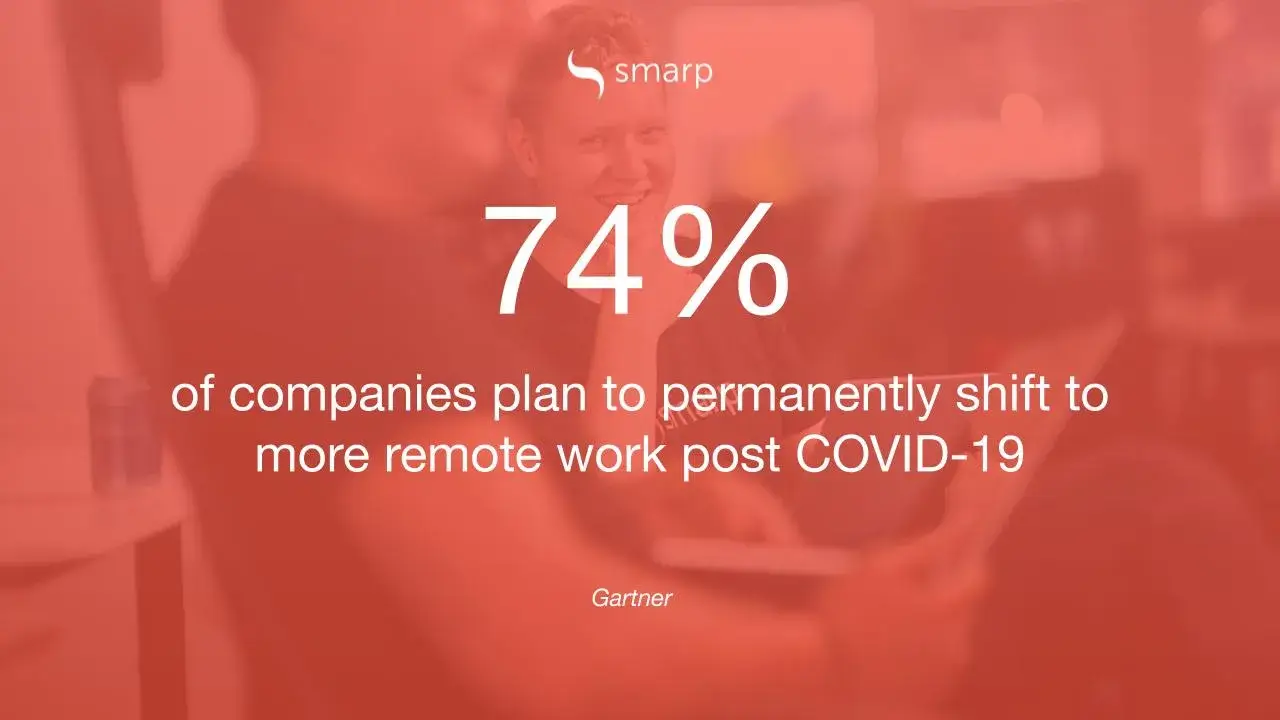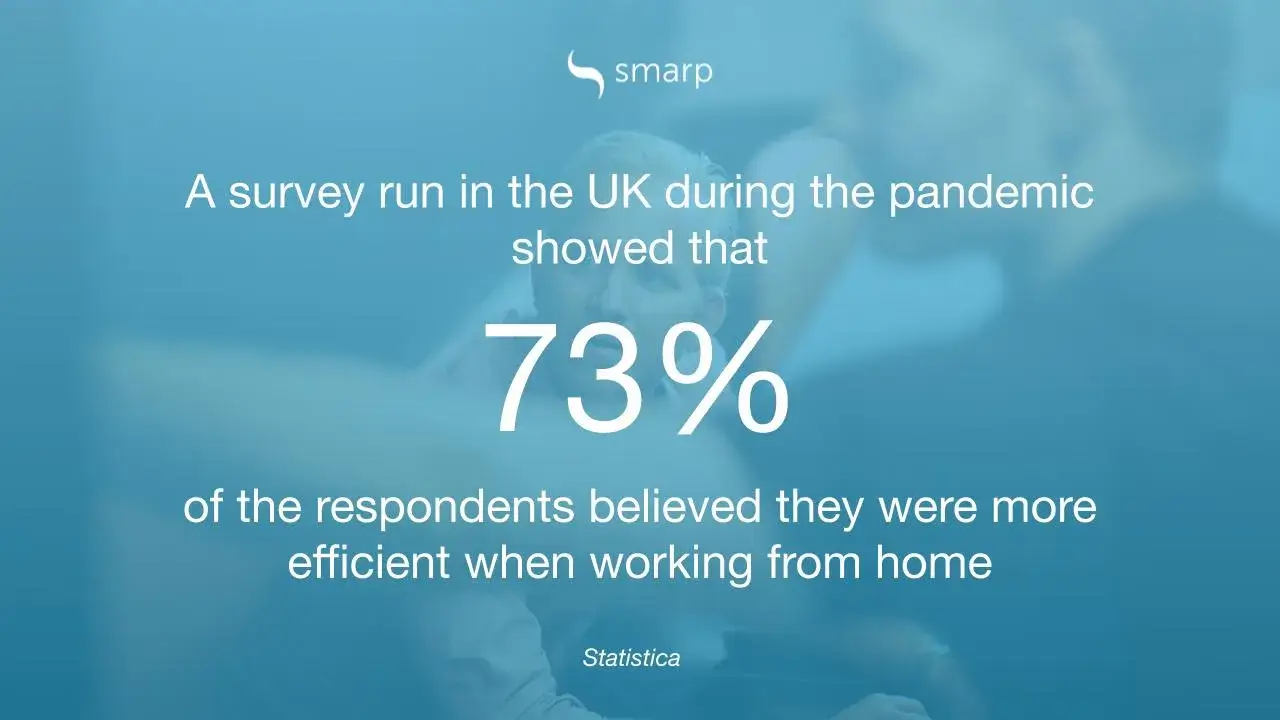14 Internal Communication practitioners share their best practices for engaging a distributed workforce in the new normal.
The pandemic has reshaped the workplace. The way we work, communicate and interact with our colleagues has drastically changed in no time.
📚Download our eBook “10 Principles of Modern Employee Communications” and learn how to communicate with the modern employee in today’s digital age.
Everything started in March, when most organizations asked their employees to work from home right after the WHO declared COVID-19 a global pandemic. In the U.S., 62 percent of employees worked at home during the crisis, compared with about 25 percent a couple of years ago.
All of the sudden, employees had to adopt new work habits and cope with new communication practices and tools.
💡Read on: Change Management: Definition, Best Practices & Examples
But the thing is, the new ways of working that we saw emerging during the pandemic aren’t temporary. Indeed, remote work is here to stay.
The Shift to Remote Work Has Redefined the Workplace
Some experts talk about “the new norm” or “the new normal” while for others, the shift to remote work we’re experiencing right now is “the post-pandemic work-from-home revolution”.
No matter what adjectives we use to describe the shift to remote work, we all are talking about the same thing: ever-changing workplaces, turning digital, where workforces are geographically dispersed.

And here’s why: some companies are extending their COVID-19 remote work policies to a) protect their employees from the virus (even though the worst of the crisis is behind us, new COVID-19 cases are found every day) and b) support their employees’ well-being and productivity.
💡Read on: Remote Work: 20 Ways to Engage and Connect with Your Remote Employees
Indeed, some businesses realized that employees increased their productivity while working from home during the pandemic and they want to maintain these work arrangements to help their employees be successful.

Tech Giants Are Already Rethinking the Way They’re Communicating with their Employees
Google already announced that employees whose jobs can be done remotely will be able to work from home until summer 2021.
“To give employees the ability to plan ahead, we are extending our global voluntary work from home option through June 30, 2021 for roles that don’t need to be in the office,” Pichai wrote in an email to employees, which Business Insider reviewed.
“I hope this will offer the flexibility you need to balance work with taking care of yourselves and your loved ones over the next 12 months”, says Google CEO Sundar Pichai.
The other GAFA companies have decided to extend their work from home policies too: Facebook employees can work from home through the end of 2020 while Apple and Amazon employees will have the option to work remotely through January 2021.
Twitter CEO Jack Dorsey goes one step further by announcing that employees may be able to permanently work from home.
And the list goes on. Indeed, business experts and analysts expect other businesses to embrace the work-from-home revolution led by these top tech companies.
So, what does that mean for IC practitioners?
As some employees will keep working from home while others have already returned to the office and other employees — including frontline employees — whose jobs can’t be done remotely are on site, workplace communication is getting more and more complex.
💡Read on: 10 Shocking Internal Communications Stats You Can’t Ignore
That means that IC professionals have to find new ways of communicating with employees, no matter where they are located — in the office or at home.
But driving effective communication and fostering collaboration between teams that are geographically dispersed doesn’t come easy.
Internal communicators need to segment their internal audiences and target their messages accordingly. They’ll have to find the right channels so they can reach the entire workforce as well as targeted groups of employees on time. They’ll also have to find the right solutions to enhance collaboration between virtual teams.
💡Read on: Interpersonal Communication: Definition, Importance and Must-Have Skills

To help you with that, we asked 14 internal communication experts from different industries to share their #1 tip to engage a distributed workforce.
Here’s what they had to say:
14 Internal Communication Experts Share Their Tips to Engage a Distributed Workforce
Claudia Preda, Global Internal Communications Specialist @ TomTom

“It might be a given for many but, now more than ever, knowing your audience is key. Just because all your employees fit under the description of a ‘distributed workforce’ doesn’t mean they can all be engaged with the same approach. In that sense, the old comms rules still apply.
Once you’re clearer about who you’re trying to reach and what your employees expect from this new set-up, then it’s all a matter of taking another look at your strategy, understanding if it is still relevant or not, and ultimately getting your creativity on.
New content series, online events, “ask me anything” sessions, toolkits for managers, team events, new engagement and communication tools – there is no one-size-fits-all answer to this. Different colleagues will expect different engagement initiatives, and what works for your company might not work for another business. The possibilities are endless, why not try something new and have fun with it?”
Michele Martin, Manager, Internal Communications, Strategic Priorities @ London Health Sciences Center

“My number one tip from my perspective is to schedule more check-ins (phone and video check-ins) with the team.
At our organization, we recommend that leaders have weekly one-on-one sessions with staff, which allows a check-in on wellbeing as well. Ensure all meetings are purpose-based and appropriate in length. We encourage staff to use video at least once a week for our team check-in”.
Mariana Lamadrid Padilla, Corporate Communications Advisor @ CEMEX

“My #1 tip to engage a dispersed workforce is to build smart, not constant communication.
Yes, it is still important to share content on a regular basis, but it’s also very important to be aware of the saturation of information our employees are receiving right now – both within the company and from external sources.
In times like this, curating and synthesizing the most important messages into content that can be quickly consumed by our workforce is paramount.
We have to keep in mind that employees are juggling other challenges besides just remote work, including caring for family, adapting to rules of interaction in order to do basic things – like grocery shopping, etc.
In our company, we’ve taken advantage of the fact that all areas have their focus set on this one topic. It has helped us leverage talent from all our functions, creating diverse task forces that have proven so far to add much more value to the way we holistically plan and produce communications content, efficiently sharing work throughout our global operations, reducing the need for rework from our local teams”.
Ellie Moore, Learning & Communications Manager @ Wilmington plc

“A shift to remote working through Covid-19 has undoubtedly thrown up many challenges, but we’ve seen some more positive shifts too.
Without people being physically in an office, there has been no ‘London centre of gravity’ and we’ve seen people from all corners of our global business engage in conversations, which has been great.
I think it’s been really important for us to make sure people feel a stronger sense of purpose – something more than just their job – throughout this time.
People’s stories, team achievements, and celebrating small milestones along the way have brought people in and made everyone feel they are a part of something. A shift from not just ‘what’ is being done, but ‘how’ and ‘where’ it’s being done and sharing that has been and will continue to be really important for us”.
Justin Robbins, Communication Expert, IOIC Fellow, Co-Founder of Fit2Communicate

“There has been a shift happening for some time now, where more people are working on a portfolio basis. This means they work for several companies at the same time.
For communicators, this presents a challenge in terms of engaging them when they are more transient. The Covid-19 pandemic has brought a work from ‘anywhere’ approach more to the fore, so communicators are working to engage both transient and remote workers.
But they are still people. And for most people, we want authentic connections, which starts with listening. So my tip would be to put yourself in their shoes and listen – what are their hopes, fears, and needs that communicating with them will help with?”
Irina Panayotova, Senior Employee Communications Professional, Sutherland Alumna

“Many would say that the new working realities and the fact that most employees are now dispersed require a significant change or revolution in the internal comms strategies. But I wouldn’t agree with that. In fact, the new realities prove the vital role of internal communications’ core purpose – to create a sense of team and shared purpose.
It is difficult to name only one tip to engage a distributed workforce, so I will mention the most important ones according to me:
- Create (or at least try to create) an engaging and inclusive environment and atmosphere by leveraging the right tools and initiatives. The tools will give you the technical ability to create this environment, but then the most important thing is to craft the right strategy with these tools. For example, what will happen in the new channel or platform you’ve launched? The main goal here is to create a spirit of togetherness, enhance conversations, or lead them if necessary.
- Give people an opportunity and a way to speak their voice – every person has the need to feel heard and connected, especially in times of social distancing. Be careful about the possible danger of having physical isolation becoming real isolation between teams or team members. Try to prevent working in silos by encouraging team or company-wide meetings and conversations.
- Help managers communicate more openly, honestly, and frequently. You better over-communicate than stay quiet. Managers need to lead change and gain people’s trust. If they manage to gain their trust now, this will last forever.
- Last but not least, before developing your communication plan, you need to first listen carefully. People’s needs, feelings, fears, and desires are changing quickly. Working more closely with line managers can be a good way of listening.
To sum up, my three keywords for engaging a dispersed workforce are trust, team, and flexibility”.
Meghna Bharat, Specialist, Corporate Communications

“In Communications, context is everything. Appreciation of the context of one’s business and that of the macro-environment keeps our discipline agile and responsive – a befitting mindset in quandaries like the ongoing pandemic.
Unlike social media enterprises, for instance, whose products are digital interfaces enabling them to exercise 100% remote working, as someone sharing perspectives from a different industry, I observe that employee engagement happens to walk a taut rope.
IC plays a telling role in articulating the organisation’s commitment to bend over backwards with flexible measures when it comes to ensuring impeccable employee safety.
And while broadcasting every important next step across the channels you’re using for your internal communication is essential, the endeavour is to optimally leverage your digital channels so you can convey a sense of collective resilience, belongingness and solidarity”.
Adam Chiasson, Communications Director @ Standard Chartered Bank

“With a distributed workforce, a strong organisational culture is key and internal communication can be the glue that holds it together.
It can be difficult for employees to feel like they are all part of the same organisation when so many are working from home and teams don’t spend any time together in a shared physical space.
But powerful internal communication and storytelling can help keep employees engaged and swimming in the same direction – even when they are literally oceans apart.
First, it’s critical right now, more than ever, for a company’s leaders to be very visible – whether it’s through videos, online town halls or email updates. Your leaders set the tone, role model the desired behaviours and ensure employees feel supported during tough times.
At Standard Chartered, our global management team answers questions from employees through virtual ‘Ask the MT’ sessions.
Internal content should also reflect the culture and values of your company. To engage and unite people, especially during a crisis, you want them to feel appreciated, be inspired and take pride in being part of the organisation.
Since COVID-19 started, our team has produced videos with leaders, colleagues and many clients expressing gratitude for the sacrifices made so far by employees. Other videos have shown how the bank and employees are making a real impact in our communities”.
Maiken Mandal, Digital Communications Advisor @ KPMG Norway

“When a workforce is geographically dispersed, it can be challenging to maintain a sense of belonging for employees, especially without the random “coffee machine catch-ups” and discussions over lunch at the cafeteria.
I think that many workplaces have found that adapting to a new and digital way of collaborating has proven to be easier than first assumed, but months of working from home have certainly made it clear that work relationships are important for our wellbeing, collaboration and the sense of being part of a team.
My #1 tip to engage a distributed workforce would be to make room for the casual chats and coffee breaks. Invite your colleagues to a weekly quiz, start the day with a 15-minute catch-up on the latest news, or plan digital lunches.
These small activities can play a big role in boosting team mentality and creating a work environment where employees feel seen and recognized”.
Kriti Pradhan, Internal & External Communications, Digital Communications for HR @ Bennett Coleman and Co. Ltd. (Times Group)

“In today’s ever-changing, fast-paced world, especially during the COVID-19 world of work, as a communication professional we require an incredible amount of foresight and planning about the business and the way we manage workplace communication.
To achieve that balance, we need to step back and put ourselves in the shoes of our employees to understand their “needs and wants” and align them with the organization’s purpose. This will also help orchestrate the business deliverables in a collaborative manner.
Here are some quick things to remember:
- Virtual
Virtual is the new normal. So anything and everything must be designed keeping this perspective in mind.
- Gauge
Understand what the employees’ wants are and balance it with what you think it should be in the current scenario. For example, our focus is “mental health and well-being for all” and “segmented learning” for others. Employees may also want to be engaged along with their family. Hence, a hybrid approach to communication would be the answer and effectively communicating it to the right audience, at the right time would be useful.
- Communicate
Communicate in a simple manner. Don’t have any frills and see if you can use alternative channels of communication instead of plain vanilla mailers. Sms, WhatsApp, gif – surprise the receiver.
- Approach
Involve Management and set examples so that “apprehension goes out of the door” and examples are set for employees. Get your leaders in front of your staff and showcase how their engagement and involvement is creating a “pull factor” for the employees.
- Appreciate
Recognition and praise in the right measure is a great way to motivate your employees. Create unique platforms to appreciate individuals who take on the role of becoming your “Advocates”. Rest is history.
Good communication is the bridge between confusion and clarity”.
Darryl Wright, Associate Partner, People Advisory Services Practice at EY Canada

“Productivity and engagement remain the key focus when working virtually.
Employers need to ensure that employees have access to the right technology to engage and collaborate remotely — this isn’t just about video conferencing, but also how innovation, creativity, and effective teaming can be facilitated with the use of think-tanks and whiteboarding enablers.
Organizations should complement technology with virtual training to facilitate awareness of how to use these tools optimally.
Employee resilience and virtual leadership are the human elements that need to be focused on deliberately when driving engagement and maintaining the desired culture.
Scheduling regular team and individual touch bases are good practice to ensure that outputs are on track, while assessing the mental health of teams.
Teams and individuals need to plan more effectively when working in a dispersed manner and this can have a favourable impact on productivity and engagement”.
Judith Smith, Quality Systems and Internal Communications Manager @ Hill Group UK

“My#1 tip: Communicate!
It can be hard enough to engage employees in the same office, let alone engage geographically dispersed employees!
Providing consistent and clear communication is key so each employee feels that sense of belonging and feels part of a team.
Recognising that everyone has different needs, a good manager will know how frequently each member of the team wants to be contacted. Managers need to make sure they have weekly or bi-weekly one-on-one meetings with all of their team members to keep the working relationship healthy.
Frequent contact also allows relationships to grow on a personal level. The manager shouldn’t just email and ideally not make a standard phone call (although this is better than nothing!), video calling is essential.
According to a famous study by Albert Mehrabian on non-verbal communication, 7% of communication is verbal, 38% is the tone and inflection and a staggering 55% was body language.
So, if you just use email, you lose 93% of the message and if you only use a phone, you lose 45% of the message while a video call allows you to get nearly 100% of the message you would if you were in the room with them.
I’d add that part of the communication should be to ensure the employee has an understanding of how their role fits into the larger goals of the organisation.
Communication should align every employee with the company goals and vision, as well as helping them understand how their individual contribution plays a part in the overall company objectives. This ultimately has an impact on employee productivity, staff retention rates and profitability”.
Dan Smith, Head of Employee Communications and Engagement @ GTR (Govia Thameslink Railway Limited)

“We’re social creatures and work provided a sense of ‘connectedness’ that wasn’t always obvious at the time.
Now, on conference calls while working from home I’ve noticed colleagues often chat more about how they’re feeling, what coffee shop they’ve been to that morning or point out something in your room such as your bookshelf or pattern on your curtains.
Let them. Don’t close that conversation down too quickly as these chats have replaced those informal ‘water cooler’ conversations.
If your living room artwork becomes a talking point, roll with it and say where you got it from and why. It helps make and maintain social connections that many teammates are crying out for”.
Ray Walsh, Communications and Internal Localization Consultant (raywalsh.net)

“Just as COVID-19 was becoming a global pandemic, I began a new engagement with an old client. One of the biggest surprises – both to the comms team and to our internal customers – was how inessential global communications proved to be!
In global companies, local managers rarely engage the comms team except to place specific orders, in formats or media of their choosing. At the same time, corporate comms teams design global campaigns with briefings that are meant to be followed to the letter.
During COVID-19, everything changed. The extent of the outbreak, local regulations, cultural requirements (e.g., willingness to wear masks), and many more made each country – and even each facility – unique. Communications HAD to be local. Managers delivered communications with local, practical detail, and from a comms perspective, things went smoothly.
Both sides had an epiphany. Corporate communications learned that global campaigns on COVID-19 weren’t manageable, and local leaders discovered that they are both responsible for communicating and capable of doing so.
This crisis has convinced me that our function must evolve from creators of content to enablers of communication. We must help local leaders and managers engage their employees, wherever they are. Those managers are in a better position to know what team members are interested in and need to know.
At the same time, some of those managers will struggle with comms tasks. We can better enable them by providing them with briefs of a communication’s purpose or desired outcome, suggested key messages that fit with the company’s purpose and goals, and visual assets that are easy to use.
We also need to be ready to advise them in the details of execution. Where necessary, we can apply our content expertise to help them deliver messages of the highest quality”.
Bottom Line
The shift to remote work companies have embraced is here to stay. As some employees are going to keep working remotely while others have already returned to the office, workforces are now geographically dispersed.
But the thing is, the situation might get even more complex.
What workplaces will look like in the near future is unpredictable as it depends on the companies’ policies, the measures taken by Governments as well as local authorities’ guidelines.
While some companies are extending their COVID-19 remote work policies, others are considering making the shift to remote work permanent.
IC experts play a key role in ensuring that businesses continue to succeed even though their workforces are geographically dispersed.
They are the ones ensuring that all employees keep up with the company updates even though they are scattered across multiple locations. They make sure that employees feel connected to their co-workers even though they can’t physically meet.
💡Read on: 8 Employee Engagement Statistics You Need to Know in 2020 [INFOGRAPHIC]
But most importantly, they are rethinking the messages they are sharing, the channels they are using as well as the way they are segmenting their internal audiences to ensure that employees are engaged, aligned with the business goals, and successful in these unprecedented times.










